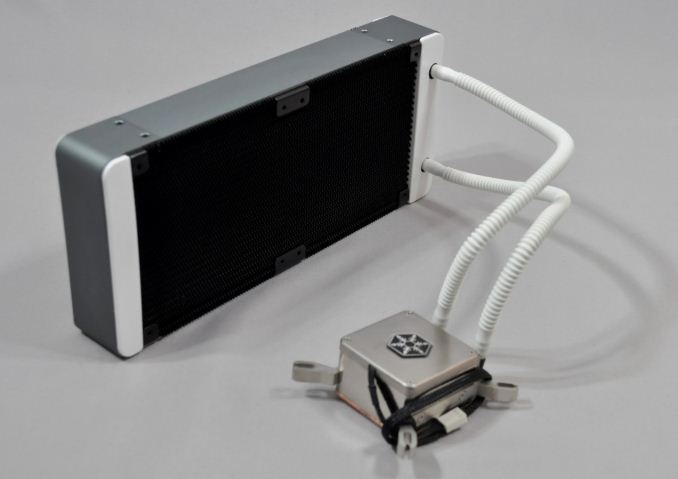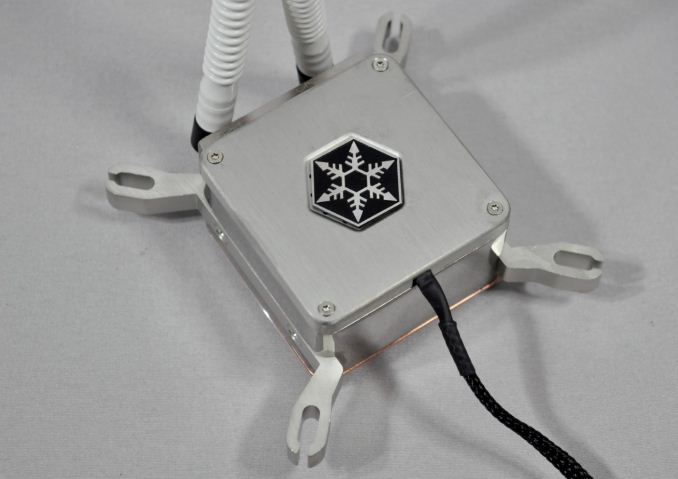Closed Loop AIO Liquid Coolers: 14-way Mega Roundup Review
by E. Fylladitakis on February 12, 2014 7:00 AM ESTSilverstone
Silverstone is another well-known name amongst advanced users and enthusiasts. The company earned their reputation from their first PSUs and original case designs and soon diversified towards cooling related products. They currently offer just two AIO liquid cooling solutions, the Tundra series. The company shipped both of them to us for this review.
Silverstone Tundra TD02
Silverstone ships the Tundra TD02 inside a large cardboard box with a black/blue theme. The box has plenty of pictures and information about the cooler printed on all of its sides. The company also supplies a fairly standard bundle with the Tundra TD02, which consists of a manual with installation instructions, mounting hardware and a syringe with thermal compound. There also is a 3-pin Y-splitter fan cable included, which can be used to power two fans off a single header. Silverstone supplies two 120mm fans with the TD02. The fans have back frames and curved, notched white blades that supposedly reduce aerodynamic noise, as well as fluid-state bearings for prolonged life. Their speed range is rather narrow, ranging from 1500 to 2500 RPM.
Visually, the Silverstone Tundra TD02 certainly stands out a lot. Although it is somewhat different, the Tundra TD02 could be coming from the same OEM that makes the Enermax Liqtech 120X as well; however, Silverstone did not want to reveal their source. The very large and deep radiator with the grey aluminum frame stands out, the size of which overwhelms any Asetek/CoolIT design. Size is not always a good thing though, as the 45mm thick design could bring serious compatibility issues, especially if the case has been designed with 27-29mm radiators in mind.
The design of the radiator is quite different from that of most other kits. Like the radiator of the Liqtech 120X, instead of wavy aluminum fins between the liquid pass-through channels, this design forms single, "seamless" fins from one side to the other, which are soldered onto the channels. The design of the fins and the overall size of the radiator though is different.
The block-pump assembly of the Tundra TD02 stands out over that of most other kits as well. It is entirely metallic, made of nickel-plated aluminum with a copper base. A badge with Silverstone's logo lies in the middle of the aluminum cap, which also has very subtle blue LEDs surrounding it. There is something unique about this block however; unlike any other assembly, including that of the Liqtech 120X, the copper base of the block is not attached to the assembly with screws, leaving the bottom of the block entirely plain. It has also been machined down to a perfect, smooth finish. The only thing that we could complain about is the use of narrow, stiff, white corrugated tubing, which is beneath the quality of such a product.
Silverstone Tundra TD03
Confusing as this may be, the Tundra TD03 actually is a smaller version of the TD02. It comes in a similarly designed cardboard box with a black/blue color theme, only it's significantly smaller. Despite the change in size however, the cooler remains very well protected within cardboard packaging and inside nylon bags. It also shares exactly the same bundle with the TD02, including the manual with the installation instructions. The two 120mm fans supplies are the same as those of the TD02, with a black frame and curved, notched white blades.
Both visually and practically, the Tundra TD03 is just a shorter version of the TD02. The radiator also shares the same design, and is just as wide and thick as the radiator of the TD02, yet nearly half as long, which means that it essentially has half the heat dissipation surface. Nevertheless, Silverstone still supplies two 120mm fans, to be used in a push-pull configuration. It is interesting to note that this radiator design appears a lot more solid, without any imperfections or bent fins, which appear to be very common on radiators with wavy aluminum fins.
As expected, the fully metallic block-pump assembly of the Tundra TD03 is identical to that of the TD02. The top and frame of the assembly are made out of nickel-plated aluminum, with the base of the block made out of solid copper. Even the mounting braces are made of solid aluminum, with those meant for Intel CPUs preinstalled on the block from the factory. Once again, the copper base is not attached to the aluminum frame with screws, at least not screws visible from the bottom of the assembly, leaving the base of the cooler perfectly clean and smooth.
























139 Comments
View All Comments
lwatcdr - Thursday, February 13, 2014 - link
And maybe the CoolerMaster Evo 212Streetwind - Wednesday, February 12, 2014 - link
Excuse me for pointing this out, but are the noise levels given here not a little bit bogus? On your "Testing Methology" page, you qualify 50-54 dB(A) as "Extremely loud (level equivalent to a ≈1500W vacuum cleaner)". Then on the next page in your 12V results, you state: "To give you a rough estimate, 56 dB(A) represents about the same level of sound as a typical box fan the same distance."Are you honestly trying to imply that a CPU fan is capable of producing a typical noise scenario that is twice as intense as a 1500W vacuum cleaner at full bore? I think that either the table under "Testing Methodology" is wrong, or you performed your tests in a way that generates results which have absolutely nothing whatsoever to do with the scale presented in the table. In both cases, said table is in dire need of a revision.
The article is very nice and no doubt took a lot of work, but with the noise levels looking as arbitrary as they do, it's very difficult to glean much value from it other than a rough order of absolute cooling performance. There's no noise floor given either, and no qualifying comparison to an air cooling solution.
E.Fyll - Wednesday, February 12, 2014 - link
That is my error. The original sentence was something along the lines of "To give you a rough estimate, 56 dB(A) represents about the same level of sound as a small vacuum cleaner over the same distance". I was then told that vacuum cleaners in the US are generally larger and much louder than their counterparts here and that the comment was edited, but I foolishly did not check the article. 56dB(A) is definitely loud, as much as two of the loudest 140 mm fans, although not as loud as a vacuum cleaner; at least not the kind of vacuum cleaners most readers here are used to. :) More like to the noise of a small hair dryer, I suppose.LancerVI - Wednesday, February 12, 2014 - link
Thanks for the explanation. When I heard "as loud as a vacuum cleaner" I was taken aback. Our vacuums are LOUD! My custom WC loop is loud, but it's no where near vacuum cleaner loud.Impulses - Thursday, February 13, 2014 - link
Now I'm intrigued by these stealthy Euro vacuum cleaners... :p3DoubleD - Thursday, February 13, 2014 - link
Me too... please review!svandamme - Tuesday, December 2, 2014 - link
take it from me , they suckConnoisseur - Wednesday, February 12, 2014 - link
It would be great to see a quiet system builder's guide with different components and form factors. My holy grail has always been a mid-upper range miniITX gaming system that's virtually silent 90% of the time. Something with a core i5 or i7 CPU and R9 270x or GTX 760 stuffed into a small case with quiet operation. Probably doesn't exist yet but one can always hope :)w1z4rd - Monday, February 17, 2014 - link
I'm running a 4770k on an Asus Maximus VI Impact with a Corsair h100i and an EVGA GTX770 in a Corsair 250D that's sitting on my desktop. Unless I'm gaming I can't hear the thing. I don't hear it when gaming either, actually, as I have a headset on.Navvie - Wednesday, February 12, 2014 - link
Ever think about asking Mike Chin at SPCR to do some noise testing for you?